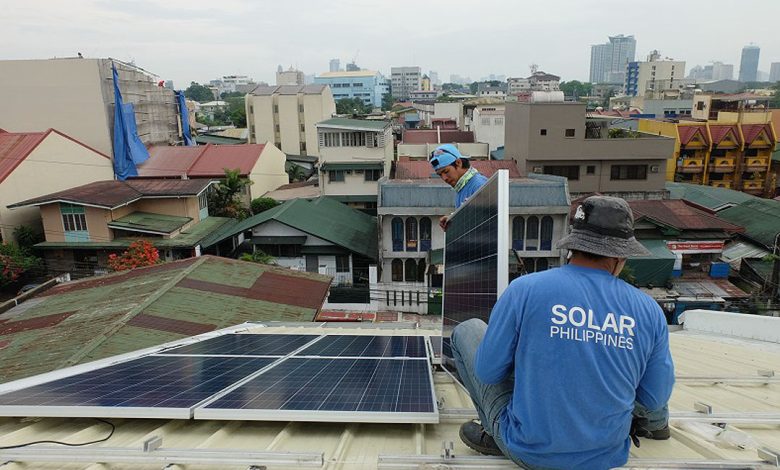Powering up Philippines’ renewable ambitions with rooftop solar

2020 marked a record-breaking year for renewable energy. Solar PV (photovoltaic) will be at the forefront of this continued opportunity in 2021-22, with renewable energy expected to account for 90% of new capacity expansion globally.
This period of accelerating growth is framed by a needed $6-trillion power sector investment between now and 2025, outpacing oil and gas investments. This is largely driven by expansion in renewable energy.
Rooftop solar installations provide an opportunity to generate significant volumes of zero-carbon renewable energy from otherwise unutilized urban and commercial environments. Solar PV is now a mature and disruptive renewable energy technology, leading capacity additions around the globe. Annual installation of solar PV is expected to reach more than 160 GW in 2022, almost 50% higher than in 2019.
The economic potential of solar rooftops has seen significant improvements over recent decades, making rooftop solar an increasingly cost-effective distributed energy solution. These innovative technologies are championed for a range of benefits for the end customers and suppliers alike — tackling the carbon intensity of generation, improving supply reliability, reducing power costs, and delivering grid independence to name but a few.
THE PHILIPPINES’ SOLAR ROOFTOP MARKET
Rooftop solar could offer a valuable path to expand on national renewable energy capacity and could be a valuable tool in achieving the Philippines’ renewed ambition of achieving over 37% share of renewables in the power mix by 2030.
Solar rooftop installations could also deliver other potential benefits for the Philippines, particularly at a time when brownouts are causing disruption in areas of high power demand. As a distributed renewable energy technology, solar rooftop installations can provide reliable power that doesn’t require electricity supplied from the power grid, offering a valuable potential to build national power resilience.
The Philippines’ solar rooftop market is nascent, with a total installed capacity of around 100 MW, although that is projected to triple to 300 MW by 2025. The market is highly fragmented, with more than 40 market participants. The top three players –Solar Philippines, Solenergy Systems, Inc., and Greenheat –currently account for half of the total installations.
The Philippines operates on a net metering approach for solar rooftop power, meaning consumers generating no more than 100 kilowatts can sell excess electricity back into the grid. The Department of Energy (DoE) estimates that almost 4,000 qualified users have signed up for net metering as of the end of 2020. Prices paid for excess energy are roughly one-third the price paid by consumers for electricity coming from the grid.
SHINING A LIGHT ON SOLAR ROOFTOP POTENTIAL
While the attractiveness of solar rooftop installations continues to grow, the business case faces some notable technical and commercial hurdles. This is ultimately a complex and often challenging market to navigate.
The attraction of reliable power can be particularly strong for commercial and industrial businesses that require electricity for business continuity. With large, often flat rooftop estates, malls are an easy entry point for rooftop solar, but the opportunity is equally apparent across other major industrial complexes. This has resulted in a growing number of businesses embracing solar rooftop technology in recent years. Shopping mall SM City Bacoor in Cavite and Robinson Malls are just some of the recent examples.
While the theoretical potential of rooftop solar is vast — more than 40 GW across the residential, commercial, industrial, and public objects in the Philippines — physical limitations and local installation challenges may significantly curtail the full scope of such ambitions.
These hurdles mean finding the right approach to boost rooftop solar potential in the Philippines will require a nuanced and localized strategy. An understanding of local market conditions, product competitiveness, and market awareness are critical to such business cases.
On the most fundamental level, rooftops need to be of a size and design to be suitable for solar installation. The more substantial a rooftop is, the greater the possibility for appropriate installation with a positive financial return.
The financial case for rooftop solar is enhanced by the potential to sell excess power generated back into the grid, providing a valuable return on investment. Yet the prices offered for this excess electricity are generally lower than grid electricity tariffs in markets across the region.
Key actions under the proposed Solar Rooftop Adoption Act should make the environment for solar rooftops more favorable. Removing the 100kW net metering cap would incentivize both large and small commercial and industrial players to adopt rooftop systems. Aligning reference prices for import and export of electricity to the grid instead of a blended generation cost would also help. Standardization of the permit process would also be a major boost.
Top-down demand should be driven by government buildings, increasing uptake of solar rooftops on both national and local government building estates. With passing the Act, solar systems could supply at least 5% of power requirements for all governments agencies, with incremental increases expected every five years.
Expanded access to low-cost financing options through the introduction of rooftop solar loan program under Pag-IBIG will also help stimulate the ecosystem. Access to capital for small-scale PV remains limited to term loans or recourse financing.
Higher buy-back tariffs for excess electricity would certainly stimulate higher penetration of solar rooftops. However, a careful balance is required. Solar rooftops and distributed generation more broadly, while bringing numerous upsides, introduce a complex environment for grid operators due to two-way power flows. Grid owners still need to maintain grid quality despite potentially suffering reduced revenue generation resulting from distributed generation. Additionally, incentives are often required to stabilize the market and avoid “boom-and-bust” cycles. A clear challenge is if a high number of solar rooftop installations benefiting from feed-in tariffs were to increase strain and overload the grid, which is already having difficulty absorbing even the relatively modest current volumes of renewable generation.
A strong partner ecosystem to leverage is another key enabler, ensuring that collaborator companies have the experience and capacity to effectively deploy solar rooftop potential. This not only facilitates a successful rollout but also helps overcome technical challenges.
Making solar rooftop technology financially viable also often comes down to the size of an operator’s portfolio. Those players with a substantial portfolio of installations are far more likely to deliver economic success than smaller players attempting to deliver returns on a limited number of installations.
THE PATH TO SUCCESS
Navigating this complex environment will require a carefully considered approach for operators. That’s particularly true in the case of incumbent utilities, who should act now if they want to take advantage of this transition.
New players are already actively entering this market, while incumbents are still searching for the right business models to build on their commercial and technical strengths. First-movers are likely to act strategically to corner market share and control the ecosystem across their value chains and collaborator networks. This will not only offer an advantage in a localized approach but also allow them to leverage the economies of scale key to a successful portfolio.
Investors and financial backers might want to consider a portfolio approach comprising multiple rooftop solar projects to de-risk early financial exposure. Focus on end-to-end business developers could offer a more rewarding pathway, with higher capital requirements but greater control.
What’s clear is that implementation remains complex, but successfully navigating that landscape will deliver remarkable opportunities for power industry operators and consumers alike.
Dr. Marko Lackovic is a partner at the Boston Consulting Group. Jaime Ruiz-Cabrero is managing director and senior partner, head of BCG Southeast Asia. The Boston Consulting Group is the consultancy partner for the 2021 UN Climate Conference.




